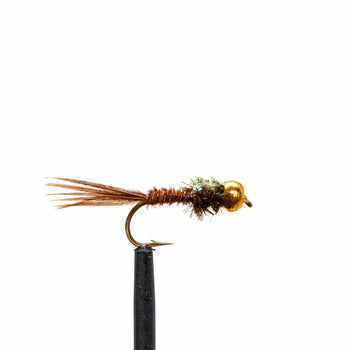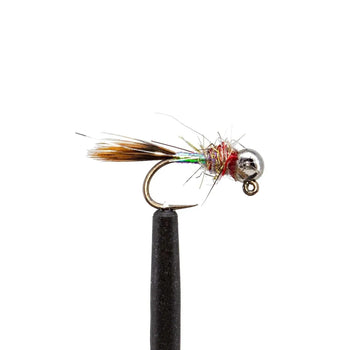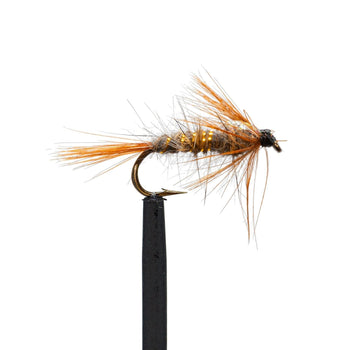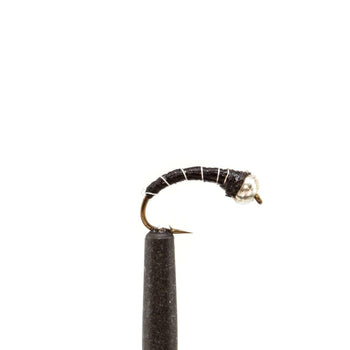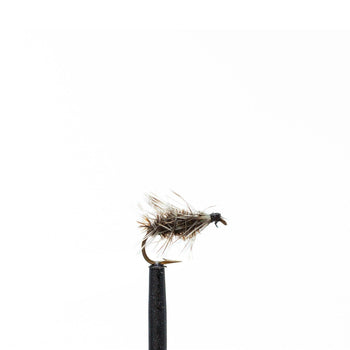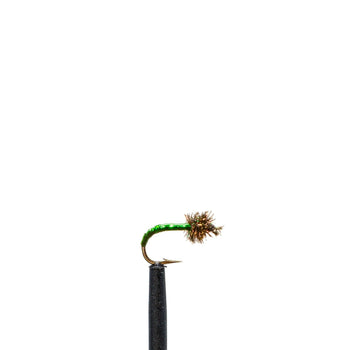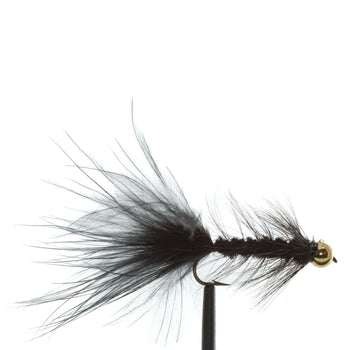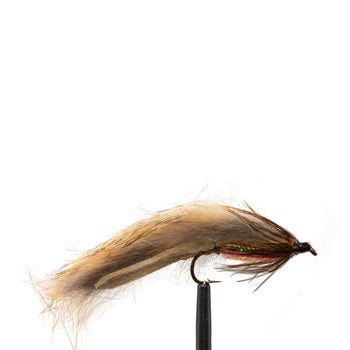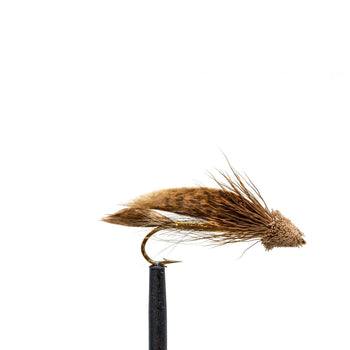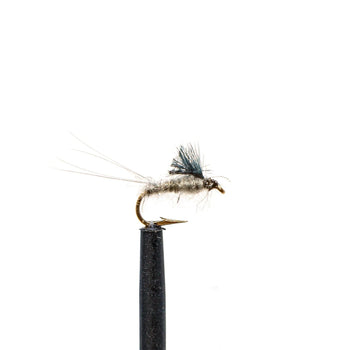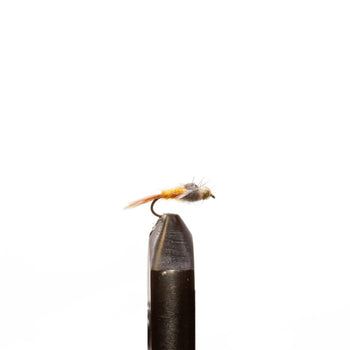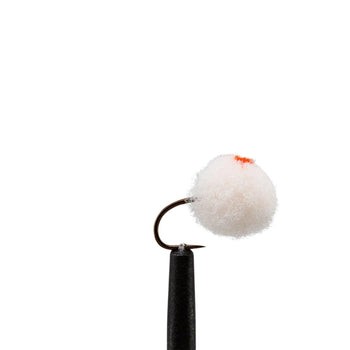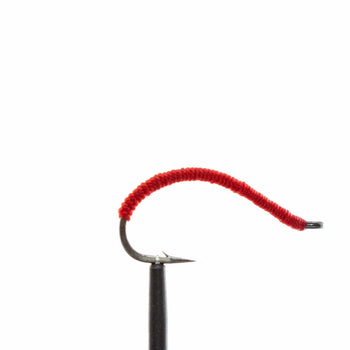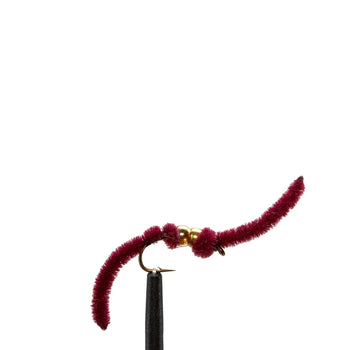20 Essential Winter Fly Patterns

Let’s face it—fly fishing in the winter presents unique challenges, from biting cold weather to limited food sources for fish. Yet, for those willing to prepare and adapt, it can also be one of the most rewarding seasons on the water. Success in winter fly fishing requires skillful techniques—like maintaining a drag-free drift and perfecting your presentation—and, of course, selecting the right flies.
A well-curated fly box is your best friend this time of year. Keep it simple with essential patterns that mimic key seasonal food sources. Ready to hit the water? Here’s a list of “must-have” flies to carry during these chilly months.
Nymphs: The Subsurface Warriors
When it comes to winter fly fishing, nymphs are the unsung heroes. These subsurface patterns shine when trout focus their feeding beneath the water’s surface—a common behavior during colder months when surface insect activity slows. Representing the juvenile stages of aquatic insects, nymphs form a crucial part of a trout’s winter diet.
Fishing nymphs demands finesse, patience, and an understanding of how these underwater creatures behave. But the reward? The unmatched satisfaction of outwitting a trout in its hidden, tranquil domain. Whether you’re fishing a single nymph or doubling up with a tandem rig, these flies are an absolute winter essential.
- Beadhead Flashback Pheasant Tail : This variant of the classic Pheasant Tail Nymph features a beadhead for quick sinking and a flashy back for added allure. It's particularly effective in winter, imitating the smaller mayfly nymphs trout are actively feeding on. Fish it slowly along the bottom, especially in deeper pools and slower currents. Sizes: 16 - 22
- Tungsten Bead Rainbow Warrior Jig : This nymph is a standout with its bright body and tungsten bead, ideal for quickly reaching the deeper waters where trout feed in winter. Fish it in off-color water or on overcast days using a steady, controlled drift. The tungsten bead helps it sink to the desired depth, making it perfect for fishing along the bottom or in deeper pools. Sizes: 16 - 20
- Flashback Hare's Ear : The Flashback Hare’s Ear adds a bit of sparkle to the traditional nymph, increasing its visibility. Employ a dead drift technique, letting the fly bounce naturally along the bottom. This approach mimics the movement of aquatic insects, making it a tempting choice for trout. Sizes: 12 - 18
Midges: The Mighty Mites of Winter Waters
Midges are a crucial food source for trout, especially from November through February, when other insects are scarce due to the cold weather. These small insects continue to hatch in large numbers, making them a reliable and abundant source of nutrition for trout. As trout adapt their feeding patterns to the available food, they focus predominantly on midges, including their larvae and pupae. This makes midges an essential target for anglers during the winter months.
For successful winter fly fishing, understanding the behavior and lifecycle of midges is key. Anglers need to mimic the size, color, and movement of midges with their artificial flies to attract trout. Paying attention to midge activity, such as their hatching times and the specific stages of their lifecycle that trout are feeding on, can significantly increase the chances of a catch. In essence, midges are not just a part of the trout's diet in winter but the mainstay, making them an indispensable element in any winter fly fishing strategy.
-
Zebra Midge: The Zebra Midge is a straightforward yet effective fly with a black or dark body, adorned with silver or gold wire stripes, and a small bead at the head for weight. It's designed to imitate midge larvae, which are commonly found in deep, slow-moving waters. When fishing the Zebra Midge, you should aim to present it near the bottom of the water column, employing a slow and steady drift. This fly is versatile and can be used effectively on its own or as part of a multi-fly nymphing rig. Sizes: 18 - 22
-
Griffith’s Gnat: The Griffith's Gnat is a classic fly pattern crafted with a peacock herl body and densely wrapped grizzly hackle. It is excellent for imitating a group of adult midges floating on the water surface. This fly is most effective when trout are surface feeding on adult midges. To fish the Griffith's Gnat, cast it to feeding fish and let it drift naturally with the current, mimicking the behavior of real midges. Sizes: 18 - 22
-
Disco Midge: The Disco Midge stands out with its shiny, reflective body, typically tied in colors like red or green, to resemble an emerging midge pupa. It's particularly effective in clear, calm waters where its reflective properties can attract trout. The Disco Midge should be fished just below the surface or at mid-water, using a slow drift with occasional subtle twitches to suggest the movement of an emerging insect. Sizes: 16 - 20
Each of these patterns is designed to mimic a specific stage in the midge life cycle, targeting trout feeding behaviors effectively: the Zebra Midge for larvae, the Griffith's Gnat for adult midges, and the Disco Midge for the emerging pupal stage.
Streamers: The Big Meal
Streamers present a dynamic and exciting approach to winter fly fishing, perfectly suited for tempting the larger, more lethargic trout that are in search of a sizeable and fulfilling meal during the cold months. Unlike smaller nymphs and midges, streamers mimic larger prey such as baitfish, leeches, and sculpins, making them ideal for triggering the predatory instincts of trout. If you are going to use a streamer try to refrain from stripping and, instead, dead-drift or swing your fly. Give slight twitches to the line so that it adds a little movement to your streamer.
-
Wooly Bugger: This timeless pattern is incredibly versatile, able to imitate a variety of trout prey from baitfish to aquatic insects. In winter, slow down your retrieve; let the Wooly Bugger sink deeper into pools and runs where trout may be holding. A series of slow, deliberate strips followed by brief pauses can be particularly effective, as it mimics the movement of a wounded or lethargic prey item. Sizes: 6 – 12
-
Zonker: Recognized for its realistic baitfish imitation, the Zonker is a go-to in colder water. The key to fishing the Zonker in winter is a slow and steady retrieve, allowing the natural fur strip to provide enticing movement. Focus on deep pools and slower-moving water, giving trout ample opportunity to spot and strike at the fly. Sizes: 4 – 8
-
Muddler Minnow: This streamer is excellent for mimicking various forage fish and even terrestrial insects that have fallen into the water. In winter, try fishing the Muddler Minnow with a slow, twitching retrieve, occasionally allowing it to rise and fall in the water column. This varying action can be especially tempting to trout patrolling beneath the surface. Sizes: 6 – 10
When fishing streamers in winter, it's important to remember that trout will generally be less aggressive and more selective due to the cold water temperatures. This means adopting a more measured and thoughtful approach, focusing on areas where trout are likely to be conserving energy, such as deeper pools and slower currents. Experimentation with retrieve speed and rhythm can be key to finding what works on any given day, as trout responses can vary with conditions and temperature.
Emergers: The Transition Specialists
Emergers are great for winter trout fishing because most of the activity is found in slower, slack water. These look great with the tapered segmented body and have an amazing profile from nearly every angle. They also sit low in the surface film, just like the real thing. It's best to use smaller sizes and often add more than one dry fly — a multi-dry fly rig.
- RS2 : The RS2, renowned for its simplicity and effectiveness, is a versatile pattern that imitates a wide range of emerging insects. In winter, it’s especially good for imitating small mayflies and midges. Fish the RS2 in the film or just below the surface, using a dead drift or gentle twitches to mimic an emerging insect. Focus on areas where you see subtle rises or where fish are likely to be holding in slower currents. The lightness of the fly allows it to stay suspended in the water column, making it an irresistible target for trout. Sizes: 18 – 22
- WD40 : This pattern is particularly effective at imitating midge and baetis emergers. The WD40’s slim profile and subtle presentation make it ideal for clear, slow-moving waters where trout can be more cautious. Fish it with a light tippet and a dead drift near the bottom or mid-water column, where emerging insects are likely to be found. You can also use the WD40 as a dropper off a larger dry fly or indicator, allowing it to drift naturally just below the surface. Sizes: 18 – 20
- Beadhead BWO Emerger : Designed to mimic the Blue-Winged Olive mayfly in its emergent stage, this fly is a winter staple. The beadhead helps get the fly to the desired depth quickly. Fish it in a dead drift, allowing the fly to rise slowly towards the surface, imitating the natural ascent of the emerging insect. The Beadhead BWO Emerger is most effective in riffles and runs where BWOs commonly hatch, and it can be especially successful during overcast days when these mayflies are most active. Sizes: 14 – 18
Emergers, in general, are about subtlety and precise presentation. The key is to mimic the vulnerable stage of an insect's life as it transitions to adulthood, making it an easy target for trout. Light tippets, careful observation of the water, and a focus on areas with emerging insect activity are crucial for success with these patterns. Adapting to the slower pace and reduced feeding aggression of trout in winter, these emergers can provide some of the most rewarding and technical fishing of the season.
Eggs: Nature's Rich Bounty
Egg patterns are a staple in the arsenal of winter fly fishers, particularly when targeting trout, steelhead, and salmon. During the colder months, these fish are gearing up for their pre-spawning stage, actively feeding to build energy reserves. Egg flies are incredibly effective during this period as they imitate the fish's natural prey – the eggs of other spawning fish. When tied in various sizes and colors, such as orange, pink, and chartreuse, they can accurately mimic different stages of egg development and attract aggressive strikes from fish.
-
Glo Bugs : With its vibrant colors, the Glo Bug is especially visible in a range of water conditions. It's an excellent choice for areas where fish are known to feed on eggs. Present this fly using a dead drift method, allowing it to roll along the bottom, just like real drifting eggs. This technique is effective in convincing trout that what they're seeing is a natural and easy meal. Sizes: 10 – 14
-
Two Egg Marabou : This pattern is unique, featuring marabou to create the texture and appearance of egg clusters. It's most effective in slower-moving waters, where the marabou fibers can move freely and naturally, simulating the subtle movements of eggs. The lifelike action of the marabou in the current can be irresistible to fish, making the Two Egg Marabou a great choice for subtly enticing trout. Sizes: 10 – 14
When fishing with egg patterns in winter, it's important to focus on the areas where fish are most likely to be holding and feeding. Look for slower currents, deeper pools, and runs, as well as areas near spawning grounds. Matching the size and color of your egg pattern to the natural eggs found in the water you're fishing can significantly increase your chances of success. As with all fly fishing, a natural presentation is key, so ensuring your egg patterns drift naturally with the current will make them more effective in attracting fish.
Worms: The Underwater Lifeline
Worm patterns play an integral role in winter fly fishing, capitalizing on the trout's natural diet that often includes aquatic worms. These worms, residing within the sediment of stream beds, are a consistent and reliable food source available to trout throughout the year. In winter, when other food sources are scarce, trout may rely even more heavily on these worms, making worm imitations an essential part of any winter fly fishing setup.
-
San Juan Worm : The San Juan Worm is a classic pattern that effectively imitates the natural aquatic worms found in many rivers and streams. Its simple yet realistic design makes it a go-to choice in a variety of water conditions. During winter, use a dead drift technique, allowing the San Juan Worm to move along the bottom where trout are likely to be feeding. The worm's movement through the sediment mimics the natural behavior of aquatic worms, making it particularly appealing to trout. Sizes: 14 – 16
-
Sparkle Worm : The Sparkle Worm adds a bit of flash to the traditional worm pattern, making it more visible in murky water or during low-light conditions common in winter. This fly is best fished using a slow, steady drift near the bottom, where its sparkling elements can catch the light and draw the attention of trout. Its luminescent quality is especially effective in attracting trout that are looking for a high-value meal in the cold, often less clear water. Sizes: 14 – 16
-
Double Bead Ultra Worm : Featuring two beads, this worm pattern is designed to sink quickly and stay close to the streambed, an essential feature for winter fishing. The extra weight helps the fly get down to the feeding zone faster, and its undulating movement in the water can be irresistible to trout. Fish the Double Bead Ultra Worm in deep pools and runs, using a dead drift approach to mimic the natural movement of worms in the current. Its ability to reach deeper holding spots makes it a valuable tool in targeting trout that tend to hold in deeper waters during colder months. Sizes: 14 – 16
When fishing with worm patterns in winter, it’s crucial to focus on presentation. Achieving a natural drift that mimics the movement of real worms in the water is key to enticing trout. These patterns are particularly effective after rain or snowmelt when natural worms are more likely to be washed into the water. By matching the size and color of your worm patterns to the natural worms in the water and focusing on areas where trout are feeding, you can significantly increase your chances of a successful catch in the winter season.
Scuds & Sow Bugs: The Hidden Feast
Scuds and sow bugs are a crucial component of a trout's diet throughout the year, and their importance is magnified during the winter months. These small, shrimp-like crustaceans thrive in streams with plenty of underwater vegetation, providing a consistent and nutritious food source for trout. In winter, when other food sources are less abundant, trout increasingly rely on scuds and sow bugs. They tend to prefer these insects in more natural colors like olives, browns, blacks, and grays, which blend well with the winter underwater environment.
-
Pink Hothead Stevie Wonder : This pattern, with its distinctive pink hot head, offers a slight variation from the natural color palette, which can be particularly effective on overcast winter days or in murky water conditions. The vibrant head can act as a trigger, drawing attention and provoking aggressive strikes from trout. Fish this pattern near the bottom, especially around areas with ample vegetation, using a slow, steady retrieve or a dead drift to mimic the natural movement of scuds and sow bugs. Sizes 18 – 22
-
Orange Hothead Ray Charles : Similar to the Pink Hothead Stevie Wonder, the Orange Hothead Ray Charles pattern incorporates a bright orange bead that can attract trout in low visibility conditions. This pattern is effective in imitating the natural movements of scuds and sow bugs as they forage among the streambed vegetation. Use a slow retrieve or a dead drift, focusing on areas with a lot of underwater plants or debris where trout might be searching for these crustaceans. Sizes 18 – 22
-
Colored Scud : Embodying the essence of natural camouflage and subtlety, the Colored Scud pattern is a quintessential imitation of the scuds found in the clear, cold waters of winter streams. Its muted hue perfectly matches the natural appearance of these crustaceans as they navigate through underwater vegetation, making it an irresistible choice for trout seeking a familiar meal. This fly's effectiveness is heightened in clear water conditions, where its authentic color and texture blend seamlessly with the surroundings, enticing even the most cautious of trout. Employ a gentle, methodical retrieve or allow for a natural dead drift near the streambed, particularly around areas rich in plant life, to best mimic the scuds' movements. Sizes 14 – 18
When fishing with scud and sow bug patterns in winter, remember that presentation is key. Achieving a natural drift that closely mimics these crustaceans' movements is crucial. Trout are often found feeding close to the bottom in areas with vegetation or other structures that provide habitat for scuds and sow bugs. By choosing patterns that blend well with the natural environment and adapting your technique to the conditions, you can effectively target trout feeding on these abundant winter food sources.
Final Thoughts
Winter fly fishing is a test of skill and knowledge, where understanding the trout's cold-weather feeding habits becomes as crucial as the choice of fly. The carefully selected nymphs, emergers, streamers, and imitations of eggs, worms, scuds, and sow bugs are all tailored to mimic the limited food sources available in the winter months. Patterns like the Beadhead Flashback Pheasant Tail, Zebra Midge, and Beadhead Wooly Bugger, among others, are designed not just for their visual appeal but for their ability to replicate the natural movements and appearances of the trout's prey. This selection allows anglers to adapt to the varied and specific feeding behaviors of trout, offering the best chance of success in the challenging winter conditions.
The essence of winter fly fishing lies not only in the selection of the right fly but in the angler's approach to presenting these patterns in a manner that appeals to the trout's instincts. With the right combination of patience, stealth, and precision, each fly—from the nymphs that dredge the riverbed to the streamers that flash through the water—has the potential to turn a quiet winter day into a moment of connection with the natural world. As anglers navigate the serene, stark beauty of winter rivers, these carefully chosen flies become their silent language, speaking to the rhythms of the water and the life beneath its surface.
SHOP OUR WINTER FLY COLLECTION
RELATED ARTICLES:


